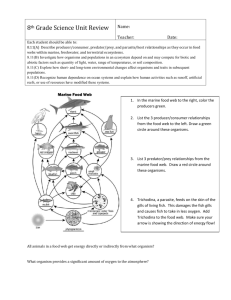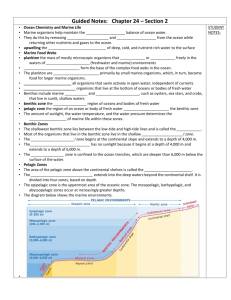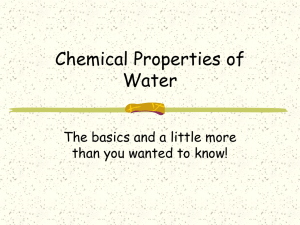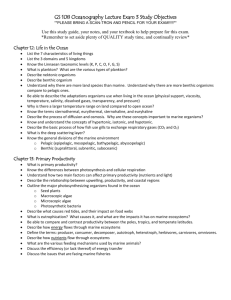Midterm review activity
advertisement
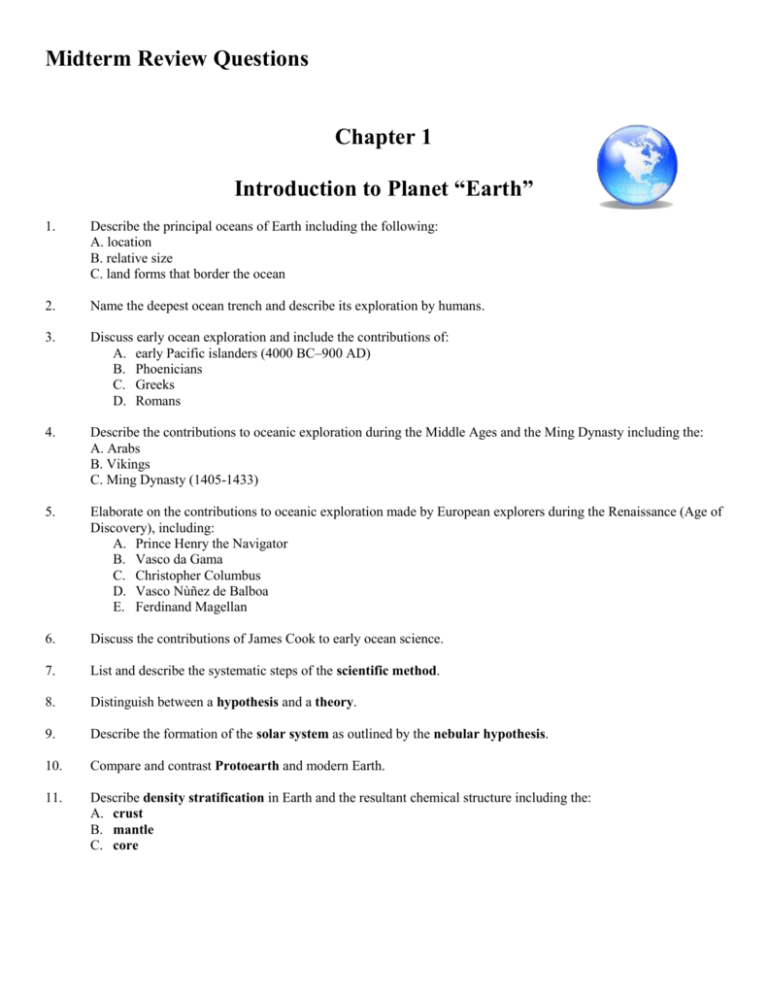
Midterm Review Questions Chapter 1 Introduction to Planet “Earth” 1. Describe the principal oceans of Earth including the following: A. location B. relative size C. land forms that border the ocean 2. Name the deepest ocean trench and describe its exploration by humans. 3. Discuss early ocean exploration and include the contributions of: A. early Pacific islanders (4000 BC–900 AD) B. Phoenicians C. Greeks D. Romans 4. Describe the contributions to oceanic exploration during the Middle Ages and the Ming Dynasty including the: A. Arabs B. Vikings C. Ming Dynasty (1405-1433) 5. Elaborate on the contributions to oceanic exploration made by European explorers during the Renaissance (Age of Discovery), including: A. Prince Henry the Navigator B. Vasco da Gama C. Christopher Columbus D. Vasco Nùñez de Balboa E. Ferdinand Magellan 6. Discuss the contributions of James Cook to early ocean science. 7. List and describe the systematic steps of the scientific method. 8. Distinguish between a hypothesis and a theory. 9. Describe the formation of the solar system as outlined by the nebular hypothesis. 10. Compare and contrast Protoearth and modern Earth. 11. Describe density stratification in Earth and the resultant chemical structure including the: A. crust B. mantle C. core 12. Describe the physical structure of Earth including the: A. inner core B. outer core C. mesosphere D. asthenosphere E. lithosphere 13. Distinguish between continental crust and oceanic crust including location, chemical, and physical properties of the crust. 14. Differentiate between isostatic adjustment and isostatic rebound. 15. Describe the formation of Earth’s initial atmosphere. 16. Describe the formation of Earth’s oceans and discuss the origin of the salts in ocean water. 17. Discuss the implications of Stanley Miller’s experiment involving the simulation of primitive Earth’s atmosphere on the origin of life on Earth. 18. Discriminate between evolution and natural selection. 19. Define the following terms: A. autotroph B. heterotroph C. anaerobic D. chemosynthesis E. photosynthesis F. respiration G. endothermic (endergonic) H. exothermic (exergonic) 20. Outline the effects of photosynthesis on primitive Earth’s atmosphere. 21. Describe the process of radiometric dating and its implications estimating Earth’s age. Sample questions: 1. What is the difference between a sea and an ocean? (Ch. 1, Section “How Many Oceans Exist on Earth?”) 2. What invention made accurate open ocean navigation possible by determining longitude? 3. What is a scientific theory? (Ch. 1, Section “Theories and the Truth”) 4. Which of the following would isostatic adjustment apply to? (Ch. 1, Section “Earth’s Internal Structure”) a. b. c. d. The floating of the lithosphere upon denser mantle beneath The adjustment of species’ behavior/structures (adaptations) to new environments The adjustment of the amounts of CO2 released during photosynthesis The formation of our solar system Chapter 5 – Water and Seawater 1. Differentiate between an atom and a molecule. 2. Describe the structure of an atom including the arrangement, relative size, and charge of the subatomic particles: proton, neutron, and electron. 3. Define ion and give an example. 4. Discuss the formation of covalent bonds between atoms. 5. Explain how the geometry of the water molecule contributes to its polarity. 6. Describe the formation of hydrogen bonds and discuss how hydrogen bonding between water molecules affects the physical and chemical properties of water. 7. List the reasons why water is considered a universal solvent. 8. Outline how hydrogen bonding affects the thermal properties of water. 9. Distinguish between heat and temperature and give the units of measurement for each. 10. Define: A. melting point B. freezing point C. boiling point D. condensation point 11. Compare and contrast heat capacity and latent heat. 12. Discuss how the physical properties of water affect global climate including marine and continental effects. 13. Explain how the geometry of the water molecule affects the density of water as it changes states of matter. 14. Define salinity and discuss its origin and concentration in seawater. 15. Restate the principle of constant proportions. 16. Name the instrument used to accurately measure dissolved salts in seawater. 17. Discuss the factors that affect the salinity of coastal and surface ocean waters. 18. List the processes that decrease seawater salinity. 19. List the processes that increase seawater salinity. 20. Draw and explain the hydrologic cycle. 21. Define residence time and discuss the implications of residence time for substances dissolved in seawater. 22. Distinguish between an acid and an alkaline (base) and describe how the relative concentrations of ions are measured. 23. Discuss the forms of dissolved carbon dioxide that exist in the ocean and the relationship between water pH and the form of dissolved carbon dioxide that is present. 24. Outline how salinity varies with depth in the ocean. 25. Outline how density varies with ocean depth. 26. Differentiate between a halocline, a pycnocline, and a thermocline and discuss the location of each in the ocean. 27. Discuss the two box model of the ocean (mixed surface layer and deep water) and describe the separation of these water masses. 28. Outline common methods for desalination and discuss their commercial viability. Sample questions: 1. Many of the unique properties of water, such as cohesion and its reputation as a universal solvent, come from its atomic structure. What causes these properties? (Ch. 5, Section “The Water Molecule”) 2. Why does ocean temperature change little from day to night? (Ch. 5, Section “Water’s Thermal Properties”) 3. Be able to discuss how latent heat of evaporation (and its equivalent, the latent heat of condensation) moderate climate. 4. Be able to explain under what circumstances local salinity is increased and decreased (i.e. Evaporation Sea ice melting etc…) 5. Why does water have strong surface tension? 6. Why are lakes like the Dead Sea and Great Salt Lake so buoyant? 7. Water in the ocean combines with carbon dioxide to form a weak acid called carbonic acid. But the ocean’s pH is 8.1 on average, which is slightly basic. How is this so? (Ch. 5, Section “The Carbonate Buffering System”) Chapter 12 Marine Life and the Marine Environment 1. Describe the classification of living organisms including the following taxonomic distinctions: A. domain (1). Archaea (2). Bacteria (3). Eukarya B. kingdom (1). Monera (2). Protista (Protoctista) (3). Fungi (4). Plantae (5). Animalia C. phylum (= division for organisms with cell walls) D. class E. order F. family G. genus H. species 2. Describe the classification of marine organisms as a function of their habitat including: A. plankton (1). classified according to nutrition and cell type (a). phytoplankton (b). zooplankton (c). bacterioplankton (2). classified according to size (a). macroplankton (b). picoplankton (c). holoplankton (d). meroplankton B. Nekton C. Benthos 3. Discuss the distribution of marine life in the zonation of the oceanic water column including: A. pelagic environment B. benthic environment 4. Outline the physical and physiologic adaptations of organisms to life in the marine environment including: A. strategies for body support B. strategies to prevent sinking (1). surface area to volume ratio (2). increasing surface area by adding appendages, spines, projections, etc. C. streamlined body shape 5. Compare and contrast thermal tolerance in marine organisms including stenothermal and eurythermal organisms. 6. Compare and contrast euryhaline and stenohaline organisms. Give an example of a euryhaline and stenohaline marine/estuarine organism and describe the environment in which it would live. 7. Distinguish between diffusion and osmosis. How does the type of environment (living versus non-living) and the state of matter affect these processes? 8. Distinguish between hypertonic, hypotonic, and isotonic solutions in terms of net water movement. What are the implications for living cells placed in each of these environments? 9. Discuss the strategies employed by marine and freshwater fish to maintain salt and water balance. 10. Detail the strategies employed by marine organisms to accomplish gas exchange. 11. Explain the relationship between the transparency of water and the kinds of color patterns exhibited by open ocean organisms. How do the strategies of countershading, disruptive coloration, and transparency affect predation? 12. Describe the relationship between depth and atmospheric pressure in the ocean. 13. The ocean environment is divided into two distinct zones: open water (pelagic) and bottom (benthic). 14. The pelagic environment is divided into two provinces: the neritic (coastal) province and the oceanic province. The oceanic province is further subdivided as a function of depth: A. epipelagic zone B. mesopelagic zone C. bathypelagic zone D. abyssopelagic zone 15. Distinguish among the following oceanic zones as a function of light availability: A. euphotic (photic) zone B. disphotic zone C. aphotic zone Sample questions 1. Describe the lifestyles of plankton, nekton, and benthos. Why is it true that plankton account for a much larger percentage of the ocean’s biomass than benthos and nekton? 2. Discuss some adaptations other than size that are used by organisms to increase their resistance to sinking. 3. List the differences between cold- and warm-water species in the marine environment. 4. Describe the process of osmosis. How is it different from diffusion? What three things can occur simultaneously across the cell membrane during osmosis? 5. What is the problem requiring osmotic regulation faced by hypotonic fish in the ocean? How have these animals adapted to meet this problem? 6. How does the depth of the deep scattering layer vary over the course of a day? Why does it do this? Which organisms comprise the DSL? Chapter 13 Biological Productivity and Energy Transfer You only need to review for those topic we finished covering this semester the unit will be concluded in Semester 2 Learning Objectives 1. Define biomass in the context of the marine environment. 2. Define primary productivity and distinguish between photosynthesis and chemosynthesis with respect to primary productivity. Name locations in the ocean in which you would expect to find photosynthetic and chemosynthetic organisms. 3. Differentiate between gross primary productivity and net primary productivity. How do the metabolic processes of photosynthesis and cellular respiration relate to gross and net primary productivity? 4. Outline the methods used to estimate primary productivity in marine environments including: A. plankton nets B. Gran method (= light and dark bottles) C. SeaWiFS (Sea-viewing Wide Field-of-View Sensor) 5. Name the nutrients that limit primary productivity in marine environments. 6. Describe the sources of nutrient input into ocean systems including: A. coastal run-off B. river input C. upwelling 7. Define the compensation depth for photosynthesis and describe how it is measured. 8. Explain the relationship between the compensation depth, the euphotic zone, and the depth to which solar radiation penetrates the ocean. How do these relationships change in coastal waters as opposed to waters of the epipelagic open ocean? 9. Provide an explanation as to why marine life is more abundant in coastal waters as compared to the open ocean. List all factors (biological, chemical, geologic, and physical) that affect species diversity, biomass, and the distribution of life in the ocean. 10. Detail the electromagnetic spectrum for visible light and explain the relationship between wavelength and energy. Discuss the implications of this relationship for light penetration in marine environments. 11. Describe the measurement of water clarity in aquatic systems. What is the relationship between clarity and turbidity? How are these concepts related to primary productivity? 12. Discuss the relationship between the color of ocean water and the productivity level of that area. 13. Define eutrophic. How is eutrophication related to nutrient input? To primary productivity? 14. List the photosynthetic organisms commonly found in marine environments, their taxonomic classification, and their preferred habitat including: A. sea grasses (Kingdom Plantae, Division Angiospermae [or Anthophyta]) – textbook uses Spermatophyta B. cord grass, Spartina alterniflora (Kingdom Plantae, Division Angiospermae [or Anthophyta]) C. mangroves, Rhizophora and Avicennia (Kingdom Plantae, Division Angiospermae [or Anthophyta]) D. brown algae (Kingdom Protista, Division of Phaeophyta) E. green algae (Kingdom Protista, Division Chlorophyta) F. red algae (Kingdom Protista, Division Rhodophyta) G. golden algae (Kingdom Protista, Division Chrysophyta) H. diatoms (Kingdom Protista, Division Bacillariophyta) I. coccolithophorids (Kingdom Protista, Division Haptophyta) J. dinoflagellates (Kingdom Protista, Division Dinoflagellata or Pyrrophyta) 15. Describe the formation of a harmful algal bloom (HAB). List the causative organisms and the environmental factors that contribute to the development of HABs. 16. Compare and contrast the productivity of polar, temperate, and tropical oceans. Describe the physical, chemical, and geologic factors that contribute to productivity differences as a function of latitude. Apply what you have learned in previous chapters. 17. Define entropy as it applies to marine systems. 18. Distinguish between a community and an ecosystem. Give an example of each that you would find in a marine environment. 19. Differentiate between autotrophic and heterotrophic modes of nutrition. Give an example of a marine organism that would employ each nutritional strategy. 20. Define each of the following terms that describe the position of an organism in the food chain (trophic level) and an example of a marine organism that fits the category including: A. producer B. consumer C. decomposer 21. Distinguish among the following types of consumers in terms of the food they eat and their position on the food chain, and give an example of a marine organism that would fit into each category including: A. herbivore B. carnivore C. omnivore D. bacteriovore 22. Define detritus and describe how detritus fits into the energy flow in a marine ecosystem. 23. Describe the biogeochemical cycling of the following nutrients in the ocean: A. carbon B. nitrogen C. phosphorus D. silica 24. Describe the various feeding strategies employed by marine organisms including: A. suspension (filter) feeding B. deposit feeding C. carnivorous feeding 25. Know the relationship between trophic level (caloric content) and the trophic transfer efficiency (gross ecological efficiency). What are the biological implications of a 90% energy loss between adjacent trophic levels? 26. Distinguish between a food chain, a food web, and a biomass pyramid. 27. Describe the role of microorganisms in the marine environment. 28. Differentiate among the following types of symbiotic relationships and give an example of each including: A. commensalism B. mutualism C. parasitism 29. Define fisheries. 30. Define maximum sustainable yield (MSY). Discuss how MSY is determined and the implications of yield exceeding MSY, overfishing. 32. Define by-catch and describe how the amount of by-catch relates to the type of fishing gear used and the area fished. 33. Discuss the impact of an addendum to the Marine Mammals Act in 1992 on dolphin populations and tuna fishing. How has “dolphin-safe” tuna labeling impacted accidental dolphin mortality rates in the tuna industry? 34. Distinguish between purse seines and drift nets (gill nets). Discuss the amount of by-catch resulting from the use of these nets. 35. Detail the regulation and management of commercial fish species including: A. regulation of fishing vessels B. gear regulation C. limits (weight, size, and sex) D. limiting season to ensure successful reproduction E. regulating licenses F. enforcement 31. Outline how consumer choices affect commercial fisheries. Make recommendations regarding how consumer choice can impact fisheries management and harvest of target species. Sample questions 1. Chemosynthesis is a method of primary productivity. How does it differ from photosynthesis? 2. How does gross primary productivity differ from net primary production? What are the two components of gross primary production, and how are they different? 3. Why does everything in the ocean at depths below the shallowest surface water take on a blue-green appearance? 4. What factors create the color difference between coastal waters and the less productive open-ocean water? What color is each? 5. Generally, the productivity in tropical oceans is rather low. What are three environments that are exceptions to this, and what factors contribute to their higher productivity? 6. What conditions create ocean eutrophication (dead zones)? What can be done to limit their spread? 7. Describe the flow of energy through the biotic community and include forms into which solar radiation is converted. How does this flow differ from the manner in which mass is moved through the ecosystem? 8. When a species is overfished, what changes are there in the standing stock and the maximum sustainable yield? What are some problems with fisheries management?


